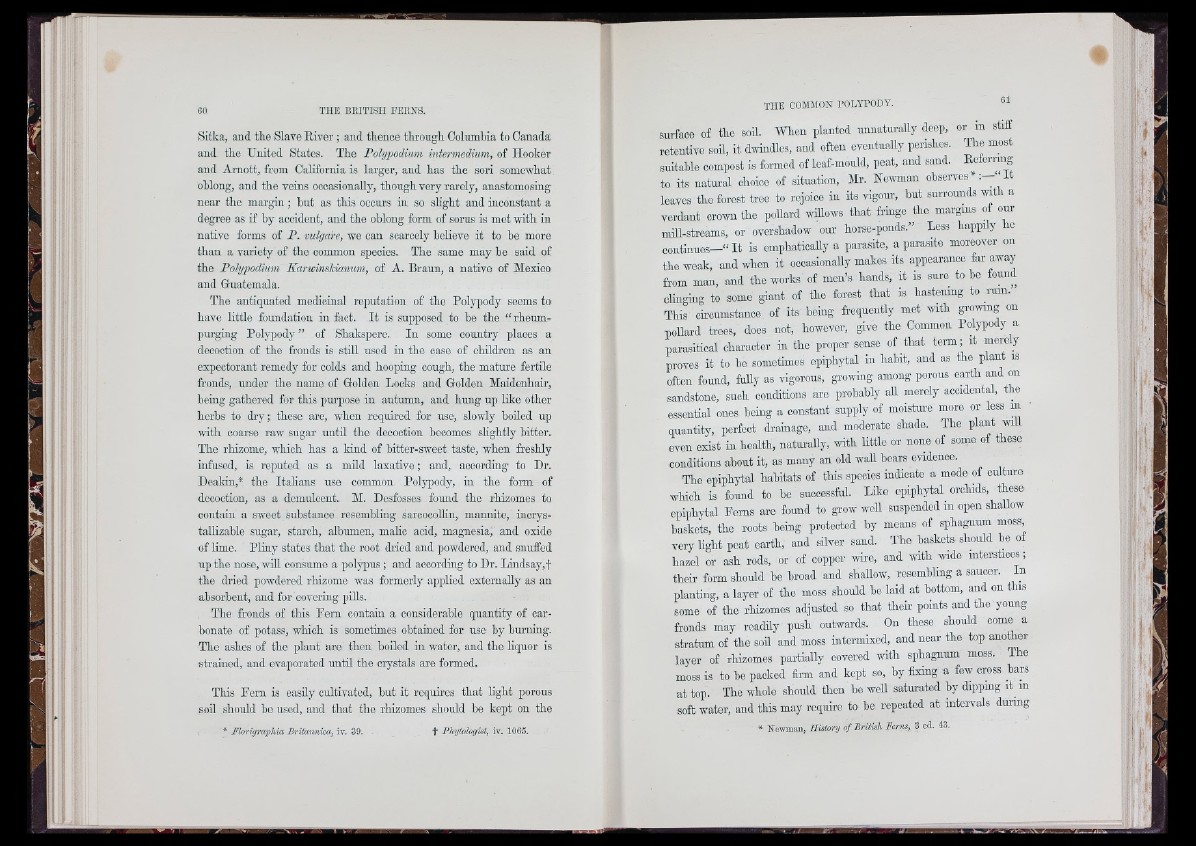
Sitka, and the Slave River ; and thence through Columbia to Canada
and tho United States. The Folypodium intermedium, of Hooker
and Arnott, from California is larger, and has the sori somewhat
oblong, and the veins occasionally, though very rarely, anastomosing
near the margin ; but as this occurs in so slight and inconstant a
degree as if by accident, and tho oblong form of sorus is met with in
native forms of P . vulgare, wo can scarcely believe it to be moro
than a variety of the common species. The same may be said of
tho Folypodium Karwimkianum, of A. Braun, a native of Mexico
and Guatemala.
Tho antiquated modiomal reputation of tho Polypody seems to
have littlo foundation in fact. I t is supposed to be tho “ rhoum-
purging Polypody ” of Shakspore. In some country places a
decoction of the fronds is stiU used in tho case of children as an
expectorant remedy for colds and hooping cough, the mature fertile
fronds, under tho name of Golden Looks and Golden Maidenhair,
being gathered for tliis purpose in autumn, and hung up like other
herbs to d ry ; those arc, when required for use, slowly boiled up
with coarse raw sugar until the decoction becomes slightly hitter.
Tho rhizome, which has a kind of bitter-sweet taste, when freshly
infused, is reputed as a mild laxative; and, according to Dr.
Dcakin,* the Itahans use common Polypody, in tho form of
decoction, as a demulcent. M. Dosfosses found tho rhizomes to
contain a sweet substance resembling sarcocoUin, mannito, incrys-
tallizable sugar, starch, albumen, malic acid, magnesia, and oxide
of lime. Pliny states th a t tho root dried and powdered, and snuffed
up tho nose, will consume a polypus; and according to Dr. Lindsay,!
the dried pow'dored rhizome was formerly applied externally as an
absorbent, and for covering piUs.
The fronds of this Fern contain a considerable quantity of carbonate
of potass, which is sometimes obtainod for use by burning.
The ashes of the plant aro thou boiled in water, and the liquor is
strained, and evaporated until tho crystals are formed.
This Fern is easily cultivated, but it requires that light porous
soil should bo used, and that the rhizomes should be kept on the
* FlorigrapMa Britannica, iv. 39. t Phytologist, iv. 1065.
surface of the soil. When planted unnaturally deep, or m stiff
retoutive soil, it dmudlos, and often eventually perishes. The most
suitable compost is fonned of leaf-mould, peat, and sand. Rofomng
to its n a to a l choice of situation, Mr. Newman observes I t
loaves the forest tree to rejoice in its vigour, but surrounds with a
verdant croivn the poUard willows that fringe tho margins of our
mill-streams, or overshadow our horso-poiids.” Less happily e
co n tin u e s-“ I t is emphatically a parasite, a parasite moreover on
tho weak, and when it occasionally makes its appearance far away
from mail, and the works of men’s hands, it is sure to ho found
cUnging to some giant of tho forest th a t is hastening to rum.
This circumstanoe of its being frequently mot with growing on
pollard trees, does not, however, give the Common Polypody a
parasitical character in the proper souse of that term; it merely
proves it to be sometimes epiphytal in habit, and as tho plant is
often found, fully as vigorous, growing among porous earth and on
sandstone, such conditions arc probably aU merely accidental, tho
essential ones being a constant supply of moisture moro or less m '
quantity, perfect drainage, and moderate shade. Tho plant wiU
even exist in health, naturaUy, vdth littlo or none of some of these
conditions about it, as many an old waU boars evidence.
The epiphytal habitats of this species indicate a mode of culture
which is found to be successful. LAe epiphytal orchids, these
epiphytal Ferns arc found to grow woU suspended in open shallow
baskets, tho roots being protected by means of sphagnum moss,
very Hght peat earth, and silver sand. The baskete should ho ot
hazel or ash rods, or of copper wire, and with wide interstices;
their form should be broad and shallow, resembling a saucer. In
planting, a layer of the moss should be laid at bottom, and on this
some of the rHzomos adjusted so that thoir points and the young
fronds may readily push outwards. On these should come a
stratum of the soil and moss intermixed, and near the top another
layer of rhizomes partially covered with sphagnum moss. The
moss is to be packed firm and kept so, by fixing a few cross bars
at top. The whole should then be weU saturated by dipping it in
soft water, and this may require to be repeated at intervals during
* Newman, History o f British Ferns, 8 ed. 43.